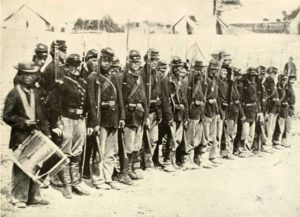Robert Burch on “California in the Civil War: Securing the State in 1861″
 California’s involvement in the American Civil War remains one of the great hidden facets of that conflict. One subject never explored by Civil War historians are the military operations within the state. Despite public expression of hope and confidence, doubt existed among senior Unionist politicians and U.S. Army officer’s regarding the prospects of preserving California in the Union in April 1861. Yet eight months later California was secured Union state after bold use of very limited Federal military resources and emergence of pro-Unionist Governor Leland Stanford.
California’s involvement in the American Civil War remains one of the great hidden facets of that conflict. One subject never explored by Civil War historians are the military operations within the state. Despite public expression of hope and confidence, doubt existed among senior Unionist politicians and U.S. Army officer’s regarding the prospects of preserving California in the Union in April 1861. Yet eight months later California was secured Union state after bold use of very limited Federal military resources and emergence of pro-Unionist Governor Leland Stanford.
The internal state Secessionist and external Confederate threat to California was real. Three lines of effort were developed to achieve their goal. Secessionists politically advocated a ballot referendum proposing to secede California from the Union and establish the “Republic of the Pacific” with intend of ultimately joining the Confederacy. At the same time, they militarily pursued raising a Secessionist Army to seize state by force. Externally the Confederate Army in Texas proposed capturing Southwest U.S. with assistance from California, Nevada and Arizona volunteers (the New Mexico Campaign, discussed in a later presentation).
This presentation describes this threat and the Union response. It is the product of original research that drew on multiple original and secondary sources, principally the Official Records and various secondary local history articles. This story is described in rough chronological order:
- Non-Military Actions Laying Foundation for Bloodless Military Victory
- U.S. Army Secured San Francisco
- U.S. Army Secured Los Angeles & San Diego
- U.S. Army Secured San Bernardino
- California Volunteers Relieved Regular Army Units
- California Volunteers Secured Southern California
- Measurement of Success – Capture of Daniel Showalter
What is the so what? It’s relevance. First, how state politicians and U.S. Army leaders secured California for the Union in 1861 offers insight into a successful counter-insurgency operation. Secondly, unlike similar situations in the Border States during the Civil War, and the nation as a whole, this success was without bloodshed or lingering, deep division among the civil population. Finally, the state “economic boom” resulting from the Federal government’s appreciation to California for its loyalty after the war is still attracting immigrants to California over 150 years later.
Bob Burch is a native Californian, born and raised in Santa Clara County. He is also a lifetime student of the Civil War. He had the opportunity to visit many Civil War sites from Florida to Pennsylvania to New Mexico during his 30 year military career. Like many California CWRT members, he desires to understand his home state’s role in the war. He started collecting material for this presentation ten years ago and initiated a serious study 15 months ago. This series documents his research in great detail. Time allows only a few key points from each slide to be presented. Numerous period photographs and magazine drawings are included for visual effect with the intent of comprehending California’s role in the Civil War.
